
Melaleuca amydra is a plant in the myrtle family, Myrtaceae and is endemic to the south-west of Western Australia. It is similar to Melaleuca ryeae with its small, compact form, oval leaves and "pom-pom" heads of pink to purple flower heads on the ends of the branches in spring.

Melaleuca barlowii is a plant in the myrtle family, Myrtaceae and is endemic to the south-west of Western Australia. It is similar to a number of other Western Australian melaleucas such as M. conothamnoides with its purple pom-pom flower heads but is a more erect shrub with different leaves and the fruiting clusters have a different shape.
Melaleuca boeophylla is a plant in the myrtle family, Myrtaceae and is endemic to the south-west of Western Australia. It is similar to a number of other Western Australian melaleucas such as M. filifolia with its purple pom-pom flower heads but its leaves are shorter and oval in cross-section.
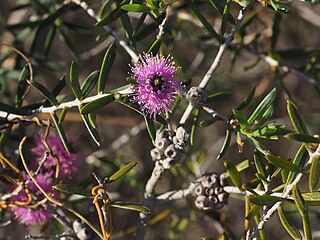
Melaleuca caeca is a plant in the myrtle family, Myrtaceae and is endemic to the south-west of Western Australia. It is similar to a number of other Western Australian melaleucas such as M. pentagona with its purple pom-pom flower heads but it is a smaller shrub with narrower leaves and smaller inflorescences.

Melaleuca campanae is a plant in the myrtle family, Myrtaceae and is endemic to the south-west of Western Australia. It is a small, woody shrub similar to Melaleuca eulobata, with a low, spreading habit and pinkish flower heads but it has longer, pointed leaves and lacks distinct sepals which instead form a ring of tissue around the edge of the flowers.
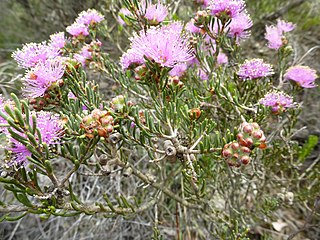
Melaleuca carrii is a plant in the myrtle family, Myrtaceae and is endemic to the south-west of Western Australia. It is a small shrub similar to Melaleuca pentagona, with "pom-pom" heads of pinkish flowers and sharply pointed leaves but it is generally smaller, lacks a groove in its leaves and retains its petals on the flowers for longer than that species.
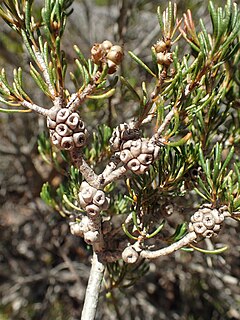
Melaleuca clavifolia is a plant in the myrtle family, Myrtaceae and is endemic to the south-west of Western Australia. It is a small shrub similar to Melaleuca tinkeri, with "pom-pom" heads of pinkish flowers and soft, silky hairs on the new growth but it has larger flower heads and its leaves are shorter, more club-shaped and have less distinct oil glands.

Melaleuca calyptroides is a plant in the myrtle family, Myrtaceae and is endemic to the south-west of Western Australia. It is similar to a number of other Western Australian melaleucas such as M. hollidayi with its almost cylindrical leaves, purple pom-pom flower heads and low growth habit but it has longer, wartier leaves and fewer flowers in the inflorescences. The floral cup and woody capsule from which it develops are longer than those of similar melaleucas.

Melaleuca hollidayi is a plant in the myrtle family, Myrtaceae and is endemic to the south of Western Australia. It is a small shrub with fine hairs like spider web on its leaves, and bright pink flowers.

Melaleuca huttensis is a plant in the myrtle family Myrtaceae, and is endemic to the south-west of Western Australia. It is a small, woody shrub with elliptic leaves, mostly crowded near the ends of the branches which are tipped with heads of white or yellow flowes during spring and early summer. It is a threatened species, potentially endangered by the construction of the Oakajee Port near Geraldton.
Melaleuca idana is a plant in the myrtle family, Myrtaceae, and is endemic to the south-west of Western Australia. It is a small shrub with fine, silky hairs covering the new foliage and heads of pink to deep purple flowers in early spring. It is similar to Melaleuca sapientes, differing mainly in the shape of the leaves in cross-section and the length of its styles.
Melaleuca keigheryi is a shrub in the myrtle family, Myrtaceae with white, papery bark and is endemic to the west coast of Western Australia. In spring, it has heads of pink flowers which fade in color to become white.
Melaleuca lara is a plant in the myrtle family, Myrtaceae and is endemic to a small area on the west coast of Western Australia. It is similar to Melaleuca ciliosa with its hairy young leaves and heads of yellow flowers ageing to red but there are fewer flowers in each head and the leaves are generally smaller.

Melaleuca leuropoma is a plant in the myrtle family, Myrtaceae and is endemic to the south-west of Western Australia. It is a small to medium-sized shrub which flowers over an extended period with flower colour varying from purple to yellow or white. The glossy, often brown petals covering the flower buds are also an unusual characteristic of this species.
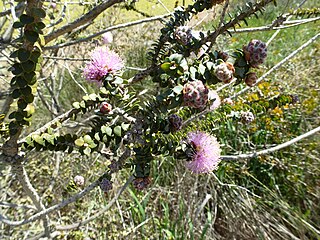
Melaleuca orbicularis is a plant in the myrtle family, Myrtaceae and is endemic to the south-west of Western Australia. It is similar to Melaleuca cordata with its pinkish "pom-pom" heads of flowers but its leaves are smaller, almost circular compared to the heart shaped leaves of the other species.

Melaleuca ryeae is a plant in the myrtle family, Myrtaceae and is endemic to the south west of Western Australia. It is a small shrub, closely resembling Melaleuca amydra with its small leaves and profuse heads of pink to purple flowers but M.amydra has narrower leaves and does not have spherical clusters of fruits.
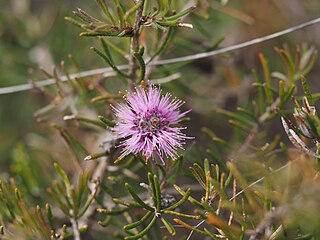
Melaleuca tinkeri is a plant in the myrtle family, Myrtaceae and is endemic to the south-west of Western Australia. It is one of the smallest melaleucas and is distinguished by its warty, hairy leaves, heads of pinkish flowers in late winter to spring and its spherical fruiting clusters.
Melaleuca venusta is a shrub in the myrtle family Myrtaceae and is endemic to the west coast of Western Australia. It is a shrub with silvery leaves and heads of pink to purple flowers which fade to white and with a restricted distribution, north of the Murchison River district.

Melaleuca dichroma is a shrub in the myrtle family, Myrtaceae and is endemic to the south-west of Western Australia. It is unusual for its genus in that its flowers are yellow or creamy-white but age to a pinkish-red.

Melaleuca spectabilis is a plant in the myrtle family, Myrtaceae, and is endemic to the south-west of Western Australia. It was formerly known as a subspecies of Melaleuca longistaminea. It is a low, prickly shrub with yellow or lime-green flowers in spring and early summer.

















